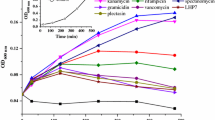Abstract
Linezolid is an oxazolidinone compound that has been shown to have impressive antimicrobial activity against a number of Gram-positive bacteria. It inhibits an initiation step of protein synthesis, and its binding site has been shown to be on the 50S ribosomal subunit. Linezolid was tested to see whether would interfere with the formation of the 50S subunit in Staphylococcus aureus cells, since a number of other 50S-specific antibiotics have this second inhibitory function. Linezolid inhibited protein synthesis in S. aureus cells with an IC50 of 0.3 μg/ml. A concentration-dependent decline in cell number with an increase in generation time was found. Pulse-chase labeling studies revealed a specific inhibitory effect on 50S particle formation, with no effect on 30S subunit assembly. The compound inhibited 50S synthesis with an IC50 of 0.6 μg/ ml, indicating an equivalent effect on translation and particle assembly. A postantibiotic effect of 1 h was found when cells were initially treated with the drug at 2 μg/ ml. 50S particle numbers recovered more rapidly than translational capacity, consistent with the increase in viable cell numbers. The inhibitory activities of this novel antimicrobial agent in cells are discussed.
Similar content being viewed by others
Author information
Authors and Affiliations
Additional information
Received: 28 June 2001 / Accepted: 27 August 2001
Rights and permissions
About this article
Cite this article
Champney, W., Miller, M. Linezolid Is a Specific Inhibitor of 50S Ribosomal Subunit Formation in Staphylococcus aureus Cells. Curr Microbiol 44, 350–356 (2002). https://doi.org/10.1007/s00284-001-0023-7
Issue Date:
DOI: https://doi.org/10.1007/s00284-001-0023-7




